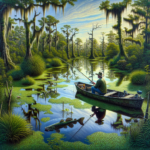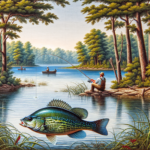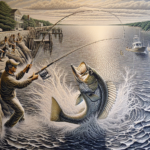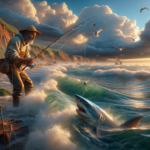Gar Fishing in Louisiana’s Bayous

Introduction
Did you know that the alligator gar, one of the largest freshwater fish in North America, can grow up to 10 feet long and weigh over 300 pounds? This prehistoric-looking fish is a prized catch for anglers in Louisiana’s bayous, where the unique ecosystem provides an ideal habitat for these giants. In this article, we will explore the ins and outs of gar fishing in Louisiana’s bayous, covering everything from the best fishing techniques and gear to the top fishing spots and seasonal considerations.
Whether you’re a seasoned angler looking to master a new technique or a beginner eager to experience the thrill of catching a gar, this guide will provide you with all the information you need. We’ll delve into the historical and cultural significance of gar fishing in Louisiana, discuss the best practices for catching these elusive fish, and offer tips on how to make the most of your fishing trip.
Background/Context
Historical or Cultural Significance
Gar fishing has deep roots in Louisiana’s culture and history. Native American tribes, such as the Choctaw and Houma, have long revered the gar for its strength and resilience. The fish has also been a staple in the diets of local communities for centuries. Today, gar fishing remains a popular pastime, attracting anglers from all over the world who are eager to test their skills against these formidable fish.
Geographical Overview
Louisiana’s bayous are a network of slow-moving, swampy waterways that meander through the state’s coastal plains. These unique ecosystems are characterized by their brackish waters, dense vegetation, and abundant wildlife. The bayous provide an ideal habitat for gar, with plenty of cover and food sources. The climate in this region is typically warm and humid, with mild winters and hot summers, making it a year-round fishing destination.
Key Points/Details
Fishing Techniques
Technique Overview
Gar fishing requires a combination of patience, skill, and the right techniques. The most common methods include bowfishing, rod and reel fishing, and jug fishing. Each technique has its own set of challenges and rewards, making gar fishing a versatile and exciting pursuit.
When and Where to Use
Bowfishing is particularly effective in shallow waters where gar are more visible. Rod and reel fishing can be done from the shore or a boat, and is best suited for deeper waters. Jug fishing involves setting out multiple baited jugs and waiting for a gar to take the bait, making it ideal for larger bodies of water.
Recommended Gear
- Bowfishing: A sturdy bow with a reel attachment, heavy-duty arrows, and a spotlight for night fishing.
- Rod and Reel Fishing: A heavy-action rod, a strong reel with a high line capacity, braided line, and live or cut bait.
- Jug Fishing: Plastic jugs, heavy-duty fishing line, large hooks, and live or cut bait.
Species Information
Species Overview
The alligator gar is the primary species targeted in Louisiana’s bayous. These fish are known for their elongated bodies, armored scales, and sharp teeth. They are ambush predators, often lurking near the surface or hiding among vegetation to catch their prey. Alligator gar are most active during the warmer months, making spring and summer the best times to fish for them.
Best Practices
To successfully catch an alligator gar, it’s important to use strong, durable gear and to be patient. Gar have a tendency to play with their food before fully committing, so it’s crucial to wait for the right moment to set the hook. Using live bait, such as shad or mullet, can increase your chances of attracting a gar.
Location Information
Top Fishing Spots
- Atchafalaya Basin: Known for its vast network of bayous and swamps, this area is a prime location for gar fishing.
- Lake Pontchartrain: This large estuarine system offers excellent opportunities for catching gar, especially near the shorelines and inlets.
- Bayou Dularge: Located in Terrebonne Parish, this bayou is a popular spot for both recreational and professional anglers.
Regulations and Licenses
Before heading out, it’s important to familiarize yourself with Louisiana’s fishing regulations. A valid fishing license is required for all anglers, and there are specific regulations regarding the size and number of gar that can be caught. It’s also important to check for any seasonal restrictions or protected areas.
Seasonal Considerations
Seasonal Variations
Fishing conditions in Louisiana’s bayous can vary significantly throughout the year. During the spring and summer, gar are more active and can be found near the surface. In the fall and winter, they tend to move to deeper waters and become less active.
Best Times to Fish
The best time to fish for gar is during the warmer months, from late spring to early fall. Early morning and late evening are typically the most productive times of day, as gar are more likely to be feeding during these periods.
Events and Tournaments
Event Overview
Louisiana hosts several fishing tournaments and events throughout the year, many of which include categories for gar fishing. These events provide a great opportunity to test your skills, meet other anglers, and potentially win prizes.
Preparation Tips
To prepare for a fishing tournament, it’s important to practice your techniques, ensure your gear is in good condition, and familiarize yourself with the tournament rules. It’s also a good idea to scout the fishing location ahead of time to identify potential hotspots.
Tips and Best Practices
General Tips
- Be patient and wait for the right moment to set the hook.
- Use strong, durable gear to handle the size and strength of gar.
- Fish during the early morning or late evening for the best results.
Avoid Common Mistakes
- Don’t set the hook too early; wait for the gar to fully commit to the bait.
- Avoid using light tackle, as it may not be strong enough to handle a large gar.
- Don’t overlook the importance of scouting and preparation.
Advanced Techniques
- Try using a slip float rig to keep your bait at the optimal depth.
- Experiment with different types of bait to see what works best in your fishing location.
- Use a spotlight for night fishing to increase your chances of spotting gar near the surface.
Gear and Equipment Recommendations
Essential Gear
- Heavy-action rod and reel
- Braided fishing line
- Large hooks and live or cut bait
- Bow and arrows for bowfishing
- Plastic jugs for jug fishing
Optional Gear/Upgrades
- Slip float rig
- Spotlight for night fishing
- Fish finder to locate gar in deeper waters
Where to Buy or Rent
Local bait and tackle shops in Louisiana often carry the gear needed for gar fishing. Additionally, many online retailers offer a wide selection of fishing equipment. For those who prefer to rent gear, some fishing charters and outfitters in the area provide rental options.
Safety and Conservation
Safety Tips
- Always wear a life jacket when fishing from a boat.
- Be aware of your surroundings and watch out for wildlife hazards, such as alligators.
- Stay hydrated and protect yourself from the sun with sunscreen and appropriate clothing.
Conservation Practices
- Practice catch and release to help maintain healthy fish populations.
- Respect local wildlife and avoid disturbing their habitats.
- Follow all fishing regulations and guidelines to ensure sustainable fishing practices.
Planning Your Trip
Accommodations
There are numerous lodging options near Louisiana’s bayous, ranging from rustic cabins and campgrounds to hotels and bed-and-breakfasts. Some popular choices include:
- Atchafalaya Basin: Atchafalaya Basin Landing & Marina offers cabins and RV sites.
- Lake Pontchartrain: Fontainebleau State Park provides cabins and camping facilities.
- Bayou Dularge: Sportsman’s Paradise offers rental cabins and guided fishing trips.
Travel Tips
- Check the weather forecast before your trip and pack accordingly.
- Plan your route in advance and be aware of any road closures or construction.
- Consider renting a boat if you don’t have access to one, as it can greatly enhance your fishing experience.
Additional Activities
In addition to fishing, Louisiana’s bayous offer a variety of other activities, such as wildlife tours, kayaking, and birdwatching. Exploring the local culture and cuisine is also a must, with many opportunities to sample Cajun and Creole dishes.
Frequently Asked Questions (FAQs)
What is the best time of year to fish for gar in Louisiana’s bayous?
The best time to fish for gar is during the warmer months, from late spring to early fall. Early morning and late evening are typically the most productive times of day.
What type of bait should I use for gar fishing?
Live bait, such as shad or mullet, is highly effective for attracting gar. Cut bait can also be used, but live bait tends to yield better results.
Do I need a special license to fish for gar in Louisiana?
A valid fishing license is required for all anglers in Louisiana. Be sure to check local regulations for any specific requirements or restrictions related to gar fishing.
Can I fish for gar at night?
Yes, night fishing for gar can be very productive, especially with the use of a spotlight to spot gar near the surface.
Conclusion
Gar fishing in Louisiana’s bayous offers a unique and thrilling experience for anglers of all skill levels. With the right techniques, gear, and knowledge, you can successfully catch these impressive fish and enjoy the beauty of Louisiana’s natural landscapes. Whether you’re planning a dedicated fishing trip or simply looking to try something new, this guide provides all the information you need to get started. So grab your gear, head to the bayous, and get ready for an unforgettable fishing adventure.




